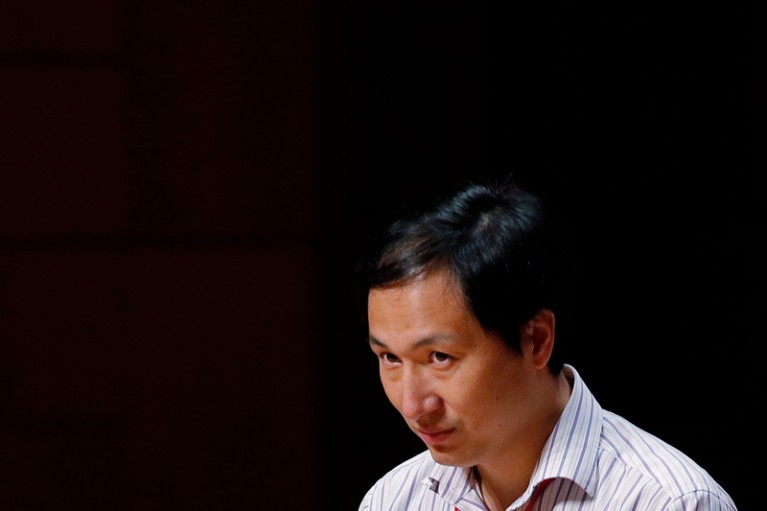
He Jiankui’s claim to have gene-edited a baby demands a response from the community.Credit: Kin Cheung/AP/Shutterstock
People like to say that science is self-correcting. Events in China last week pose a serious challenge to that reassuring platitude. How do researchers respond to the failure of medical ethics, collective responsibility and professional standards that saw an immature experimental technique used to help produce human babies?
It has not yet been independently confirmed that the Chinese genome-editing researcher He Jiankui altered the DNA of embryos using a gene-editing technique and then implanted them in a woman, as he claims. Such a step would be significant and controversial because it would make a permanent change to the germ line that could be passed on to future generations. (This distinguishes germline editing from the use of gene-editing tools as therapies that correct genetic alterations in somatic cells in blood and other tissues.)
Verification of He’s claims could be difficult, given that privacy concerns rightly protect the identity of the parents and their one-month-old twin girls. But many scientists in the field agree on two things: the relative simplicity and widespread availability of the gene-editing tool CRISPR–Cas9 mean that what He claims to have done is eminently possible; and, whether or not he is the first person to have genetically edited a baby, he will not be the last.
So, although testing the accuracy of his claim is a priority, so too is ensuring that any future efforts to genetically edit the germ line of human babies proceed in a much more regulated and responsible way. The scientific community still has the opportunity to take the lead on this — public and political reaction to last week’s news has been calmer than many might have expected — and it should do so urgently.
Some argue that the circumstances in which germline gene editing would be beneficial, such as to reverse disease-causing mutations that could not be addressed in any other way, are likely to be extremely rare. Nevertheless, given that research and medicine move fast, a clear regulatory system needs to be devised and put in place in case a credible proposal arises. Such a regulatory system should draw on those that already exist to guide the use of gene-editing tools for research into human development, and more broadly govern medical testing of innovative therapies. But it should not start with the assumption that future germline editing is a foregone conclusion — that is a question for society, not scientists, and one that demands the input of different stakeholders from across the world. Researchers and physicians must ask permission rather than beg for forgiveness.
A solid regulatory system set up by the research community can then be the basis for laws and regulations that individual nations might decide to introduce. Debate was key to framing the law that regulates a mitochondrial-replacement therapy in the United Kingdom, a procedure that also affects unborn babies and means they carry DNA from three people. (Laws are not always the best way to govern emerging medical procedures, but they do offer the deterrence of effective punishment for those who don’t follow the rules, unlike self-regulation or guidelines.)
So, how can the gene-editing community set up a better system? A starting point would be a global registry (or national registries) set up by funders or governments to record preclinical research that involves gene editing in human embryos. This would require the objectives, steps and limitations of projects to be spelled out from an early stage. The records should also detail the steps taken for ethical approval and oversight of the research. The 2016 guidelines from the International Society for Stem Cell Research are a good model to follow for regulation of research that involves human embryos and gametes, including research into germline gene editing.
Such registries could also provide a mechanism to flag research projects that do not meet high ethical and technical standards, and a route to apply pressure on individuals and their institutions to improve. And they could provide a framework, if the time comes, to define a path to the clinic. They would help to explain the risks and potential benefits to people — such as prospective parents — so they can make more informed choices.
He’s claims to have communicated his intentions and actions to the scientific community do not stand up to serious scrutiny. The community — from individual researchers to institutions — can and must do more to encourage more meaningful, transparent engagement and discussion on specific projects. In return, scientists who are trusted to carry out research have the responsibility to welcome and embrace scrutiny.

 First CRISPR babies: six questions that remain
First CRISPR babies: six questions that remain
 How the genome-edited babies revelation will affect research
How the genome-edited babies revelation will affect research
 Genome-edited baby claim provokes international outcry
Genome-edited baby claim provokes international outcry




